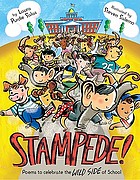
BIBLIOGRAPHY
Salas, Laura Purdie. 2009. STAMPEDE! POEMS TO CELEBRATE THE WILD SIDE OF SCHOOL. Ill. by Steven Salerno. New York: Clarion Books. ISBN 978-0-618-91488-3.
REVIEW AND CRITICAL ANALYSIS
Laura Purdie Salas has created a creative and fun book that includes 18 different poems with beautiful, full page illustrations by Steven Salerno. Kids can easily connect to the poems in the book because they are focused around a school theme. Animal attributes are imaginatively given to the students described in each school situation. For example, in "New Mouse" a mouse in a maze taking wrong turns and finding dead ends is likened to the way a student feels in a new school before they know their way around. The illustration shows a girl with a tail and mouse ears wearing school girl clothes, a backpack, and a bow in her hair trying to find her way in a maze labeled with arrows pointing to familiar rooms found in schools like gym, library, music, computers, etc. The illustrations perfectly complement the poems.
In addition to using similes and metaphors throughout the poems, Salas also uses rhyme to engage the reader. The rhymes aren't forced or overdone. In "Here, Boy," the poem begins "Lunch bell starts ringing / down the hallway I bound. / I'm a dog who's just heard / the can-opener sound." The light and humorous tone in her writing will keep kids coming back for more.
"Ducks in a Row" is an acrostic poem about kids walking in the halls at school. The letters of the word "Ducklings" are used to begin each line. The illustrations depict kids walking in a row with their hands behind their backs and their clothes look like the wings of a duck.
Ducks in a Row
Do you all
Understand how we walk while in school?
Children, listen!
Keep quiet's the number one rule.
Leave the lockers alone and
I'm sure you'll do fine.
No poking or
Giggling---and
Stay in your line!
This poem could be used at the very beginning of the school year to talk about how the teacher expects the students to walk in the hallways. Since some children might not have background knowledge on how ducks walk in a line, the teacher could show a picture or video of baby ducks following behind the mama duck.
Many of the illustrations in the book could be shown to children without reading the poem. The students could use the clues in the illustrations to infer what the poem might be about, then read the poem to see if their inferences were correct. Since the poems in this book all follow the same school theme and all give animal characteristics to humans, they could infer where the poem is taking place or the situation the poem is talking about and also what animal the author is comparing the students to.

No comments:
Post a Comment